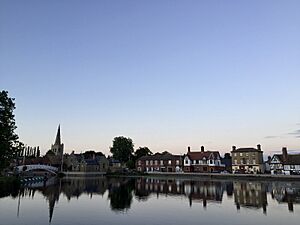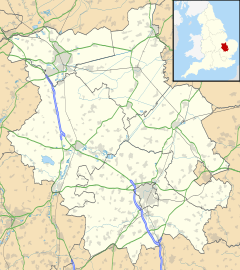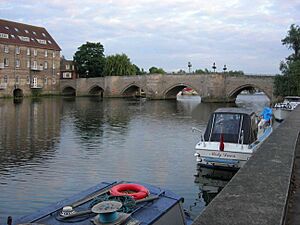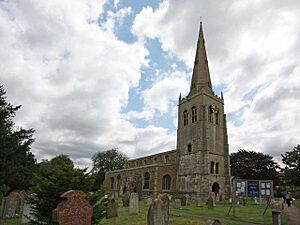Godmanchester facts for kids
Quick facts for kids Godmanchester |
|
|---|---|
 Godmanchester's Causeway, which overlooks the River Great Ouse |
|
| Area | 1.983 km2 (0.766 sq mi) civil parish |
| Population | 7,893 (2021) |
| • Density | 3,980/km2 (10,300/sq mi) |
| OS grid reference | TL245704 |
| • London | 56 miles (90 km) |
| Civil parish |
|
| District | |
| Shire county | |
| Region | |
| Country | England |
| Sovereign state | United Kingdom |
| Post town | HUNTINGDON |
| Postcode district | PE29 |
| Dialling code | 01480 |
| Police | Cambridgeshire |
| Fire | Cambridgeshire |
| Ambulance | East of England |
| EU Parliament | East of England |
| UK Parliament |
|
Godmanchester is a town in Cambridgeshire, England. It is very close to Huntingdon, just across the River Great Ouse. This town has a long and interesting history. It was built on old Roman roads.
Godmanchester is surrounded by beautiful countryside. This area is important for its many different plants and animals. The town is also easy to get to. There's a railway line to London. Major roads like the A1 and A14 are also nearby.
Contents
What's in a Name?
The name 'Godmanchester' first appeared in a very old book called the Domesday Book in 1086. Back then, it was spelled Godmundcestre. Over time, the spelling changed many times.
The first part of the name comes from an old Anglo-Saxon person's name. This name was either Guðmund or Godmund. The second part, 'chester', comes from the Latin word 'castrum'. This word means 'fort' or 'camp'. It refers to an old Roman fort that was south of the River Great Ouse.
Some people still say the town's name as Gumster. But most people today say Godmunchester, with the stress on the first part.
Godmanchester's History
Godmanchester is built on the site of an old Roman town called Durovigutum. People have lived here for more than 2,000 years. Before the Romans, there is proof that Celtic people lived here.
Unlike its neighbor Huntingdon, many old things have been found in the center of Godmanchester. These finds show how important the town was. The town has two special areas called conservation areas. These areas protect buildings from the last 400 years. You can see over 100 Listed buildings here. Many of them are old timber-framed Tudor houses. The biggest is Tudor Farm, which was built around 1600.
Before the Romans
Archaeologists found parts of a very old temple near Godmanchester. This temple was built by people in the neolithic period, which was a long time ago. Scientists used carbon dating to find out it was built between 3685 and 3365 BCE. It was even lined up with the sunrise on a special day called Beltane.
This area was likely settled because of the gravel beds. These beds made it easier to cross the River Great Ouse.
After the Romans
The Roman town was at a very important crossroads. Major Roman roads met here. These included Ermine Street (from London to York) and the Via Devana (from Colchester to Chester).
Archaeologists have found many things from the Roman times. These include a large public building called a basilica and a bathhouse. They also found a temple and a very big inn called a Mansio. Other finds include villas, farms, and even a collection of jewelry. This suggests that up to 3,000 people lived here. Around the end of the third century, the Roman town became much smaller. This was probably after attacks by Saxon raiders.
The town has been successful since Roman times because of its location. It was on the main Roman road from London to York. In the Middle Ages, it is thought that the Danes helped build a port here. They did this by digging a channel called the Mill Lade.
Godmanchester was listed in the Domesday Book in 1086. This book recorded that there were 26 areas of ploughland (farmed land). It also had meadows, woodlands, and three water mills. There was also a church and a priest.
Godmanchester officially became a town in 1212. King John gave it a special document called a town charter. This meant it had special rights. It had been a market town and a royal area for some years before that. Later, King James I gave the town another Royal Charter in 1604.
A place called Farm Hall, on West Street, was used for a secret operation. From 1945 to 1946, it was a place where German scientists stayed. Their conversations were secretly recorded. This event was later turned into a play.
Population of Godmanchester
The number of people living in Godmanchester has been counted every ten years. This is part of the UK census. The only time it wasn't counted was in 1941, because of the Second World War. In the 1800s, the population was between 1,573 (in 1801) and 2,438 (in 1861).
The biggest increase in population happened between 1981 and 1991. The number of people living in the town grew by 81% in those ten years.
Here are the population numbers since 1911:
| Parish | 1911 | 1921 | 1931 | 1951 | 1961 | 1971 | 1981 | 1991 | 2001 | 2011 | 2021 |
|---|---|---|---|---|---|---|---|---|---|---|---|
| Godmanchester | 2,130 | 2,035 | 1,993 | 2,502 | 2,955 | 5,255 | 5,996 | 6,711 | 7,893 | ||
| Population census figures from report Historic Census figures Cambridgeshire to 2011 by Cambridgeshire Insight.
The censuses of 1961 and 1971 are not shown. This is because Huntingdon and Godmanchester were joined together then. |
|||||||||||
In 2021, the area of Godmanchester was about 4,900 acres. This means there were about 10,300 people for every square mile. By 2016, Godmanchester had about 6,800 people living in 3,100 homes. It is expected that the population will grow to about 8,600 people by 2036.
Culture and Community Life
Godmanchester is a town by the water. It is surrounded by open countryside. This land is very important for its many different types of plants and animals. It is also beautiful to look at.
There are several bridges that cross the Great Ouse river to Huntingdon. The Old Bridge, Huntingdon is a very old, medieval bridge. It was the only road bridge until 1975. That year, a new road was built. Now, three other footbridges help people walk across the river.
England's largest meadow is called Portholme. You can get to it from Godmanchester or Huntingdon. This meadow is important because it helps stop floods. In the past, it was used for horse racing and early flying.
To the north and east of the town are West and Eastside Common. These are special areas of common land. They are also SSSIs, which means they are protected. The Godmanchester Nature Reserve is also nearby.
Long walking paths cross these common lands. These include The Ouse Valley Way and Pathfinder Way. There is also a path along a disused railway line. This line used to connect the old Godmanchester Station and St Ives.
South of the town center is the main office and a large animal shelter for Wood Green Animal Shelters. This charity helps animals.
Some small businesses, along with large warehouses for DHL and Coop, are on the southern edge of the town. These are located in business parks like Chord Business Park.
Old documents about Godmanchester are kept safe. These include church records, local government papers, maps, and photos. You can find them at Cambridgeshire Archives and Local Studies in Huntingdon.
Important Landmarks
Church of St Mary the Virgin
The Church of St Mary the Virgin is a Church of England church. It is a Grade I listed building, which means it's very important. The oldest parts of the church are from the 1200s. Most of the church was built between the 1200s and 1400s. The tower was added in 1623. Inside, you can see special wooden seats called stalls from the late 1400s.
In 2003, a TV show called Songs of Praise was filmed at St Mary's. They even featured a new church song called Godmanchester.
Chinese Bridge
One of the town's most famous sights is its Chinese Bridge. It connects to a water meadow. There's a local story that the bridge was built without any nails or other metal parts.
The original bridge was taken down in 2010. A new, exact copy was built and put in place. The new Chinese Bridge does have nails. Experts believe the old story was a myth. They think the original nails simply rusted away over time.
Twin Towns
Godmanchester is twinned with several towns in other countries. This means they have a special friendship.
- Wertheim am Main, Germany
- Salon-de-Provence, France
- Szentendre, Hungary
- Gubbio, Italy
The Huntingdon and Godmanchester Twinning Association helps these friendships grow.
Sports and Fun
The local football club is called Godmanchester Rovers F.C.. They play at Bearscroft Lane. Their teams play in different regional leagues.
Getting Around Godmanchester
In 2019, a new six-lane road, the A14, was opened. This road helps heavy traffic move easily. It connects the West Midlands to important ports like Ipswich and Felixstowe. It also connects to London via the M11 motorway.
Since 2020, the A1307 provides a good route for lighter vehicles. You can use it to go north into Huntingdon or south to St. Ives and Cambridge. This route has had many different names over time!
The A1198 road, also known as Ermine Street, connects to the A14. It also goes south to Royston.
Huntingdon railway station is less than 1.8 miles from Godmanchester town center. It is a major stop on the East Coast Main Line.
You can also walk to Huntingdon and the railway station. You can cross the large meadow or use National Cycle Network route 51.
Local buses in Godmanchester are run by Whippet (bus company). Route 66 goes to Huntingdon and St Neots. Routes X2/X3 go to Huntingdon or Papworth and Cambridge.
Famous People from Godmanchester
- Stephen Marshall (1594–1655), an important church leader during a time of big changes in England.
- Sir Oliver Cromwell (1562–1655), he was the uncle of Oliver Cromwell, who ruled England for a time.
- Sir William Prescott (1874–1945), a civil engineer and Member of Parliament.
- Fred Beart (1850–1895), a cricketer who was born in Godmanchester.
- Nigel Bonner (1928–1994), an expert on marine mammals in Antarctica, he lived and died in Godmanchester.
- Timothy Machin (born 1948), a cricketer who was born in Godmanchester.
- Simon Thurley (born 1962), a historian and TV presenter, he grew up in Godmanchester.
- Darren Bent (born 1984), a famous English football player who played for Godmanchester Rovers F.C. when he was young.
Images for kids
See also
 In Spanish: Godmanchester para niños
In Spanish: Godmanchester para niños









